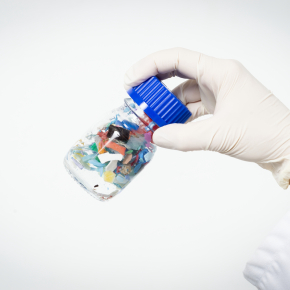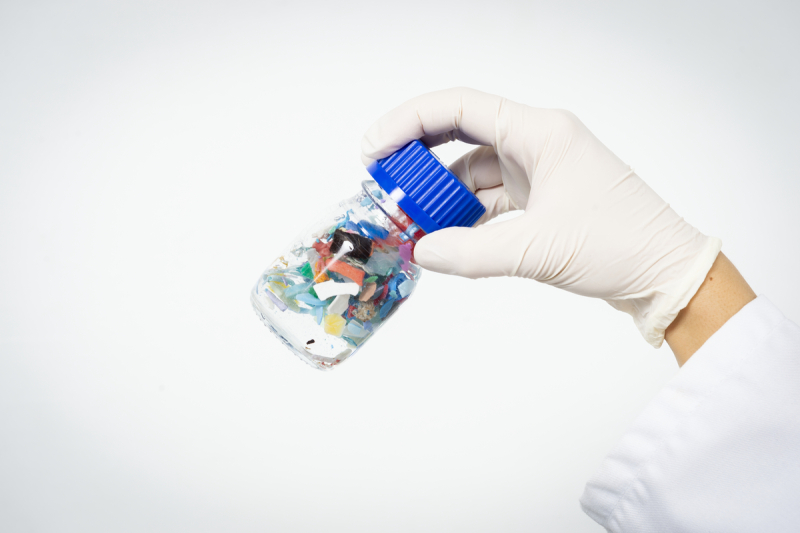Reducing plastic in research – laboratories are leading the way
With the environmental and health consequences of plastic use currently being better assessed and studied, a number of research laboratories are making efforts to measure their own plastic footprints so these can be more effectively reduced.
A dress caused a sensation at the traditional Vienna Ball of Sciences held at the start of 2024. The shades of blue that lit up the steps of the town hall were not from new dyes... Instead the colours came from 400 nitrile gloves collected by the Institute of Science and Technology Austria (Ista). For Saki, the artist, and the Ista, this was a way of bringing the prevalence of plastic in research laboratories to light.
More recently, a study found that on the global scale a biologist uses up to twenty times more plastic (1 ton per year) than, for example, a European citizen. If we calculate the figure for all disciplines then science can be said to account for 2% of the world's plastic waste. These figures are all the more striking if we factor in that plastic has invaded research laboratories in barely twenty years. Nathalie Gontard, an INRAE research professor, looks back at the use of plastic in science. "In the 1970s and 1980s, there was a first wave of plastics including novel objects like little cones for sampling very small quantities of products. The second wave in the 2000s brought about the widespread use of cheap disposable plastic in laboratories". And thus plastic bags, polyester gowns, containers, single-use gloves and glasses took the places of the cotton, wood, metal or glass objects previously used in laboratories.
Calculating research's plastic footprint
And yet, plastic's heavy carbon footprint is not the whole story as this by-product of the oil industry is the source of global pollution from the earth to the oceans and now even inside living organisms. In the face of this growing threat and at a time when plastic production is steadily increasing, many French research units are joining Redplast_up, a ground-breaking inter-institute research project with support from the National Research Agency (ANR) in the framework of the national Investments for the Future programme. This project is co-directed by Juliette Rosebery, the deputy director of the Aquitaine Observatory of Sciences of the Universe which is under the supervisory authority of CNRS Earth & Space. She explains that "Redplast_up aims firstly to take stock of plastic consumption in laboratories and also to collect alternative protocols and thus develop a database and an environmental footprint calculator for laboratories who'd like to cut their plastic footprint".
This library is currently being created via the recruitment of all laboratories that would like to cut their plastic consumption and has the full support of the CNRS which in fact made controlling its pollution and waste, including plastics, one of the hundred structuring actions set out in its Overall Sustainable Development and Social Responsibility Plan. Blandine De Geyer, the CNRS's national environmental transition officer, has "great hopes for this library of sober, eco-responsible protocols because it will enable research laboratories to avoid, substitute or optimise their use of these different plastics and to counter impacts on experiments themselves and on staff safety".
Optimising, reusing and replacing plastic
Among these new alternative protocols are those tested by Laurence Salomé and her team from seven laboratories in Toulouse who were beneficiaries of the CNRS's 'Bas Carbone' call for projects in 2023. For several months, this CNRS research professor and sustainable development officer with the Institute of Pharmacology and Structural Biology1 tested different conditions for reusing single-use plastic without there being a risk of drift in the case of biological cultures or contamination for chemical solutions. This research found that it is possible to reuse flasks2 for eukaryotic cell culture at least four times without an impact on cell mortality or the proteome3 of cell lines. The Toulouse-based scientist notes that if flasks are simply rinsed with a saline buffer then their reuse represents "undoubted savings in time and money when we look at the costs of repurchase, storage and disposal of waste when they're used once". On the downside, in biology, certain of the most commonly used plastic tubes can falsify results because any solutions they may contain are contaminated straight away by plastic additives the first time they are used. "Rinsing tubes three times in ultra-pure water before their first use and before every re-use could improve the level of reproducibility of scientific observations", explains Laurence Salomé.
Certain Redplast_up teams also replaced petroleum derivatives with other far more sustainable materials. For example, cotton garments were substituted for polyester blouses and gowns4 while glass containers replaced their plastic counterparts5 . At the same time, other researchers from the INRAE used the EcoLabWare calculation tool that has been integrated into the 1Point5 Apps platform to try to find objective proof of the ecological advantages of reusable glass as compared to single-use plastic, even for forms of usage that demand drastic washing and sterilisation procedures. The conclusion was indisputable – in all cases, reuse is still better and more advantageous than single-use plastic.
- 1CNRS / Toulouse III – Paul-Sabatier University.
- 2Flat-faced flasks on which adherent cells are cultured.
- 3All the proteins expressed in a cell or part of a cell (membranes, organelles) or in a group of cells (organ, organism, group of organisms) under given conditions and at a given time.
- 4At the Agropolymer Engineering and Emerging Technologies Laboratory (IATE).
- 5At the Micalis Institute.
The barriers and limits linked to deplastification
However, if glass and other sustainable materials have such blindingly obvious advantages, why are research laboratories not abandoning plastic straight away? The Redplast_up teams agree that the total de-plastification of science is neither feasible nor desirable. Firstly, this is because "some plastics are hard to replace, for example when you need to sample micro-volumes", explains Juliette Rosebery. Secondly, because "certain alternatives – particularly those based on reuse – can add to your workload".
The issue of the extra work caused by washing, drying and even autoclaving1 reusable glass or plastic instruments puts an even greater burden on laboratory teams because, since the advent of disposable plastic, the number of technical staff and washing facilities has been drastically reduced, if not actually totally eliminated. Laurence Salomé is well aware of this, knowing full well in advance that reusing and storing plastic tubes in her lab would take up time, space and require more organisation. She believes the de-plastification of science is "first and foremost a political choice" rather than simply a technical issue. She has thus concluded that "the environmental transition in research won't happen without extra human resources".
- 1Autoclaving consists of using steam at high temperature and pressure to sterilise culture media, materials, consumables or other instruments capable of withstanding the treatment.
The CNRS has banned plastic from its canteens
Although catering and canteens produce less waste than research laboratories, a great deal of plastic is still generated and is in direct contact with users. On January 1st 2020, the CNRS removed all single-use plastic cutlery from its restaurants in compliance with the French 'Egalim' law.
Going forward "the challenge is to move to reusable products and change people's behaviour", says Céline Andreu, catering study officer with the CNRS's Human Resources Department. She cites the renewal of the collective catering contract on the CNRS's Toulouse campus which now stipulates that non-reusable crockery and cutlery should be used for events, with deposits put on these objects for take-away sales.
The CNRS to publish a collective scientific expert report on plastics
On May 23rd 2025, the CNRS and the INRAE will present their collective expert scientific review on the plastics used in agriculture and food. The report was commissioned by the French Environment and Energy Management Agency (Ademe) and the Ministries of Agriculture and Food and Ecological Transition. This review of the scientific literature aimed at characterising the properties of such plastics according to their composition and throughout their full life cycle. It highlighted their environmental impact on continental terrestrial and aquatic ecosystems and also on health. The report also analysed the way compromises regarding the expected properties of these plastics could be taken into account for integration into an eco-design approach in compliance with health standards.



